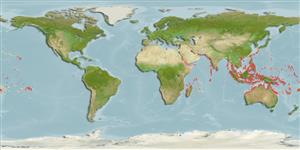Issue
Genetic data indicate that Ellochelon vaigiensis is a complex of species (Ref. 114224). At least 3 species have been recognized (Refs. 114224, 123263, work in progress) and are being described, with probable parapatric distributions (Durand, pers. comm., Nov. 2020).
Environment: milieu / climate zone / depth range / distribution range
البيئة
بحري; المياه العذبة; مياه مخلوطة مرتبطة بالشعاب; أسماك نازلة (Ref. 46888); نطاق العمق 0 - 5 m (Ref. 89972). Tropical; 32°N - 24°S, 30°E - 141°W
Indo-Pacific: Red Sea and from East Africa to the Tuamoto Islands, north to southern Japan, south to southern Great Barrier Reef and New Caledonia (Ref. 9812).
الحجم / وزن / العمر
Maturity: Lm ? range ? - ? cm
Max length : 63.0 cm TL ذكر/ مختلط الجنس; (Ref. 9710); common length : 35.0 cm TL ذكر/ مختلط الجنس; (Ref. 9812)
الأشواك الظهرية (المجموع) : 5; الأشعة الظهرية الناعمة (المجموع) : 8 - 10; شوكة شرجية: 3; أشعه شرجية لينه: 7 - 9. Diagnosis: This species is distinguished by the following characters: robust body; usually with 16 pectoral-fin rays; 25-29 longitudinal scales; 16 circumpeduncular scales; weakly ctenoid scales; adults with longer snout than eye diameter, shorter in juvenile; poorly developed adipose eyelid, forming narrow rim around eye; weak notch on anteroventral edge of preorbital; truncate caudal fin; colour olive-brown dorsally, flanks and belly silvery to whitish; about 6 brownish stripes on flank formed by longitudinal marks on scales; fins yellowish white with dusky margins except caudal fin yellow and pectoral black dorsally and yellow ventrally (completely black in young); no axillary scale visible in the pectoral fins (Ref. 9812, 90102).
Found in lagoons, reef flats, estuaries, and coastal creeks, in shallow coastal areas and protected sandy shores (Ref. 40488). Usually within tidal influence, but may enter fresh water, ascending 10 km into rivers (Ref. 40488). Forms large schools, frequently in mangrove areas (Ref. 2334). Juveniles may be found in rice fields and mangroves and may be used as bait fish (Ref. 9812). Oviparous, eggs are pelagic and non-adhesive (Ref. 205). Feeds on phytoplankton, small algae and detritus organisms (Ref. 89972). Caught in cast nets, stake
nets, beach seines, and gill nets; marketed fresh and salted; boiled (Thailand), canned or frozen (Australia). Roe also marketed salted and juveniles used as bait fish (Ref. 9812)..
Life cycle and mating behavior
النضج | التكاثر | وضع البيض | بيض | الخصوبة | Larvae
Myers, R.F., 1991. Micronesian reef fishes. Second Ed. Coral Graphics, Barrigada, Guam. 298 p. (Ref. 1602)
IUCN Red List Status (Ref. 130435: Version 2024-1)
خطر للأنسان
Reports of ciguatera poisoning (Ref. 130160)
استخدامات بشرية
مصائد: تجاري; الأستزراع المائي: تجاري; حوض مائي: تجاري; طعم: occasionally
أدوات
تقارير خاصة
Download XML
مصادر علي الأنترنت
Estimates based on models
Preferred temperature (Ref.
123201): 25.3 - 29.3, mean 28.5 °C (based on 3039 cells).
Phylogenetic diversity index (Ref.
82804): PD
50 = 1.0000 [Uniqueness, from 0.5 = low to 2.0 = high].
Bayesian length-weight: a=0.01202 (0.00759 - 0.01905), b=3.02 (2.89 - 3.15), in cm total length, based on LWR estimates for this species & (Sub)family-body (Ref.
93245).
مستوى غذائي (Ref.
69278): 2.2 ±0.1 se; based on diet studies.
المرونه (Ref.
120179): وسيط, الحد الزمني الأدني لتضاعف عدد أفراد المجتمع 1.4-4.4 سنة (Preliminary K or Fecundity.).
Fishing Vulnerability (Ref.
59153): Moderate to high vulnerability (45 of 100).
Nutrients (Ref.
124155): Calcium = 47.6 [18.7, 154.6] mg/100g; Iron = 0.591 [0.262, 1.397] mg/100g; Protein = 19 [17, 21] %; Omega3 = 0.147 [0.070, 0.313] g/100g; Selenium = 24.3 [12.2, 55.8] μg/100g; VitaminA = 54.7 [12.3, 239.4] μg/100g; Zinc = 1.78 [1.12, 2.73] mg/100g (wet weight);
